Spark Your Car's Performance: Use the Proper Spark Plugs & Spark Plug Wires

Keeping your engine operating at peak performance nowadays can require an engineering degree and thousands of dollars in test equipment. The least expensive operating part in your engine is also one of the most important - the spark plug. The spark plugs and ignition wires (or, oftentimes, connector assemblies) are the critical last pieces in the ignition system that every gasoline engine needs to operate. Maintaining these parts can be one of the only maintenance tasks left that does not require advanced test equipment - usually you just need a few hand tools that are found in most toolboxes.
How long do spark plug wires last?
Though most automakers are claiming 100,000 miles between spark plug changes and only "as needed" on the wires, few cars can make it that long without replacing these parts. This simple maintenance job can save you hundreds of dollars a year in fuel costs, avoid side-of-the-road breakdowns, and keep your car from needing even more expensive work caused by neglect of the spark plugs and ignition/spark plug wires.
Spark Plugs - Heat Ranges & Construction
First, let's look at the concept of heat range. A spark plug's heat range is its ability to transfer the excess heat from the insulator tip to the cylinder head. The speed of this transfer is commonly described by the term "hot plug" and "cold plug."
A "hot plug" means that the heat transfer is slow, causing the plug to operate at a higher temperature. A "cold plug" has a faster rate of heat transfer, thus it operates at a cooler temperature. In other words, a hot plug has a low heat range and a cold plug has a high heat range. That being said, it's easy to see how heat ranges can be confusing.
Plugs are available in different heat ranges to accommodate the operating conditions of different engines and driving conditions. A plug must operate hot enough to stay clean (i.e., not foul) and cold enough to prevent pre-ignition (premature ignition of the fuel-air mixture). If pre-ignition were not controlled, engine performance would drop and the plug would eventually destroy itself by overheating.
The heat range is determined, for the most part, by the insulator material, the length of the insulator tip, and the alloy material of the center electrode. The amount of heat transfer is affected by the size and shape of the space between the insulator and plug shell and by the quality of insulator material. A positive contact between the insulator and shell must be provided.
Here's what to keep in mind when selecting the right heat range for your car's spark plugs. A plug's heat range should be lower than the pre-ignition zone and higher than the cold fouling zone. In this lower temperature area, residues from fuel and oil additives are no longer burnt away and may cause the plug to misfire. Generally, a colder plug is better suited for high speed highway traveling. A hotter plug is better for prolonged idling and city travel.
The construction of a spark plug can and does affect performance. Materials, shapes, and assembly techniques are important to a plug's performance and lifespan. If any of these are varied, the operating characteristics are also varied. Critical parts of a spark plug and their purpose are detailed below:
Component |
Explanation |
|
Pyranit Insulator |
This is the most important part of a plug. It's made from aluminum oxide and glassy additives so it can hold up under 30,000 volts and an operating temperature of up to 1550 degrees F. The thermal conductivity of the insulator in this temperature range is crucial for establishing the plug's heat range and its performance under different driving conditions. |
|
Current Barrier |
These ceramic ribs are more than just an identifying mark. They are designed to increase the path between the terminal stud and plug shell in order to reduce current leakage. |
|
Shell |
Steel is the most common material for most shells. The shell and insulator are mated together with an electro-heat-shrinking process. Some manufacturers use zinc plating but Bosch (AutohausAZ’s largest selling brand) shells are plated with nickel. The nickel plating prevents seizing in the cylinder heads. (Zinc plating is more susceptible to seizing.) |
|
Electrode Seal |
A gas-tight seal at this location prevents "blow-by" of hot combustion gases that rob engine power. Bosch seals are made of an exclusive mixture of graphitized-metal-glass to maintain constant conductivity at all operating temperatures. |
|
Insulator Seal |
This seal performs the same functions as the electrode seal - to prevent "blow-by" of combustion gases. Also it conducts heat from the insulator to the cylinder head. This assures a consistent heat range. |
|
Threads |
In order to prevent cross-threading in the cylinder head, plug threads should be completely rolled to eliminate sharp edges. |
|
Center Electrode |
Bosch Super Plugs have a heavy duty copper core center electrode. Therefore, the plug reaches its self-cleaning temperature earlier to resist fouling in city traffic. Heat dissipation is also accelerated during highway driving. These plugs are built for heavy duty use to prevent premature erosion and corrosion. Bosch Platinum Plugs have a thin platinum rod sintered into a unique insulator design. Platinum plugs reach their self-cleaning temperature even earlier than copper core plugs. This results in quicker starts and smoother acceleration. With a 99.9 percent platinum center electrode and a unique insulator design, the platinum plug has a wider heat range than copper core plugs and reaches its self-cleaning temperature only seconds after the start. |
|
Ground Electrode |
The center and ground electrodes combine to form the spark gap. Since the ground electrode is also exposed to high temperatures and voltage, its material and size are extremely important. All Bosch spark plugs use a heavy duty rated ground electrode. |
Of all the parts in a spark plug, no part does more than the insulator. It not only has to efficiently perform a variety of functions, but it also has to have certain properties in order to do these jobs while withstanding the immense pressures, temperatures and vibrations of an engine. The insulator has two specific functions:
1. Its name describes one function. It must insulate the ignition voltage from the engine block. The insulator accomplishes this by its material and shape. Aluminum oxide and glassy additives are combined and shaped to produce an insulator with high electrical resistance. The ribs on the top portion of the insulator are also important. These molded ribs increase the distance between the terminal stud and plug shell. Thus, the resistance to leakage current is considerably improved.
2. The insulator also establishes the plug's heat range by the shape, length, and thickness of its tip. The smaller insulator of a "cold" plug absorbs less combustion heat and is able to dissipate the heat quickly. The larger insulator of a "hot" plug absorbs more heat, which it dissipates more slowly. Because it retains more heat, it is termed a "hot plug."
Spark Plugs - Troubleshooting Problems by Sight
Below are various images of plugs and some of the problems that can be identified based on spark plug appearance:
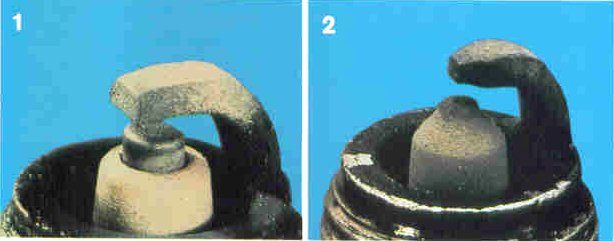
|
|
Images 1 & 2: These are normal looking spark plugs. The insulator tip is grayish white, but could also be grayish yellow to brown. This indicates the engine is in good operating condition and the heat range of the plug is correct. |
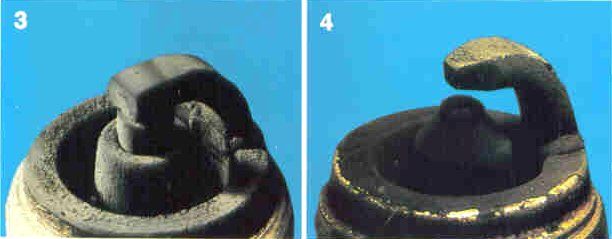
|
|
Images 3 & 4: Velvet-like, dull black carbon deposits on the insulator, electrodes and shell can be caused by any of the following: incorrect mixture, dirty air filter, faulty automatic choke, too cold a spark plug, or extreme stop & go driving conditions. To remedy this situation, make appropriate mixture adjustments, replace air filter or use a hotter spark plug in case of extreme stop & go driving conditions. |
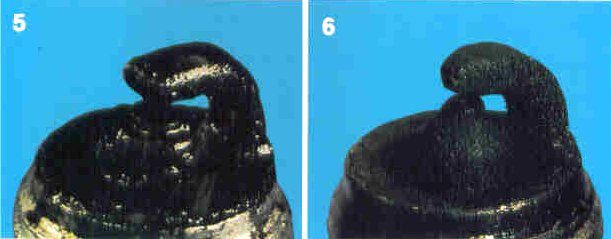
|
|
Images 5 & 6: The wet, shiny deposits shown on these spark plugs are oil. The excessive quantity of oil can result from worn cylinders, piston rings or valves. In a two stroke engine, it indicates an oil mixture that is too rich. To correct the problem, repair and/or replace worn parts. In any case, new spark plugs should be installed. |

|
|
Images 7 & 8: The yellow insulator deposits shown here are from fuel additives containing lead. With higher load, the deposit becomes conductive and causes misfiring. New plugs should be installed, cleaning is ineffective. |
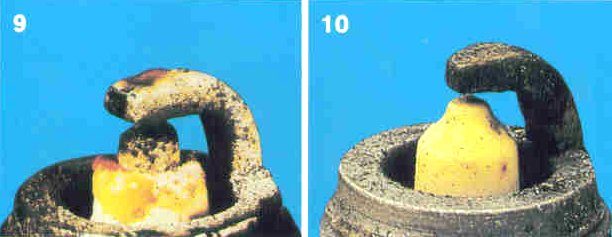
|
|
Images 9 & 10: The brownish tint in the yellow glazed deposit is a combination of carbon and lead from fuel and oil additives. They accumulate on the insulator nose during slow driving conditions and, under hard acceleration, melt. As the plug cools, the deposits solidify. Again, cleaning and sandblasting are useless; install new spark plugs. |
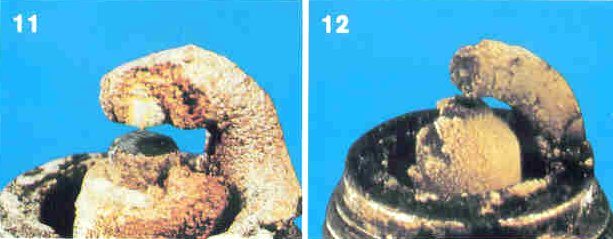
|
|
Images 11 & 12: The brownish, cinder-like deposits on the electrodes and insulator are ash residues from oil and gas additives. The alloying additives leave an unburnable ash in the combustion chamber and on the spark plug. In serious cases, it may be necessary to decarbonize the combustion chamber before installing new spark plugs. |
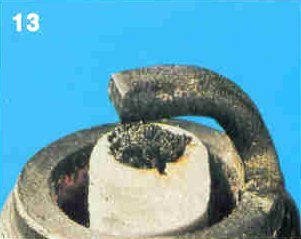
|
Image 13: A melted electrode, with a white, blistered insulator tip indicates incorrect heat range or insufficient installation torque. Note: If the insulator is separated from the shell and the shell is discolored, insufficient installation torque is the cause. If the shell is not discolored, overtorquing is the cause. Spark plug misfiring will occur and engine damage can result. A thorough tune-up should be performed and before installing new spark plugs, check the appropriate application to insure proper heat range. |
|
Image 14: The melting of the center electrode results from abnormal combustion; for example, knocking or over-advance ignition timing. Misfiring will occur. Power loss and possible engine damage can result. A thorough tune-up with new plugs is necessary. |
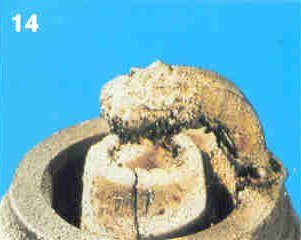
|
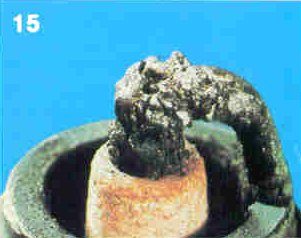
|
Image 15: The melted ground electrode shown here was caused by pre-ignition. Pre-ignition can result from hot spots in the combustion chamber, over-advanced ignition timing, lean air/fuel mixtures, defective distributor advance mechanisms, deposits in the combustion chamber, defective cylinderhead or manifold gaskets. To avoid pre-ignition, a thorough tune-up is required before installing new spark plugs. |
|
Image 16: The erosion of this center electrode is caused by not observing replacement intervals. Misfiring and poor start behavior will result. Install new spark plugs. |
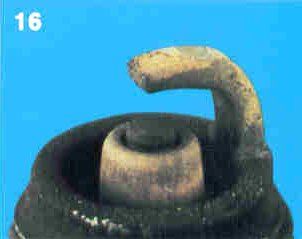
|
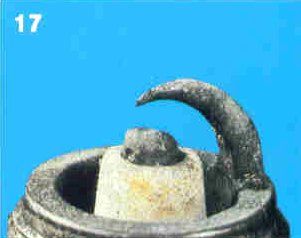
|
Image 17: The electrode erosion shown here was the result of aggressive fuel and oil additives. It was further aggravated by unfavorable gas turbulence in the combustion chamber caused by heavy deposits. This is not a heat range problem. The effects are hard starting and hesitation on acceleration. Install new spark plugs. |
|
Image 18: This damage is from impact, drop or pressure on center electrode. If the plug has been used for too long, the insulator nose can be cracked by deposits between the center electrode and the insulator and from corrosion of the center electrode. New spark plugs should be installed. |
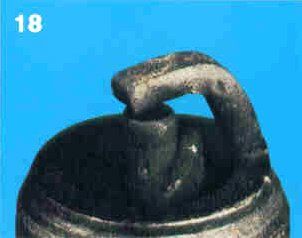
|
Find the spark plug replacements to fit your vehicle by clicking the following links. You can buy Audi parts, buy Mercedes parts, buy BMW parts, and buy parts for Jaguar and other European luxury brands for less. If you need to buy Porsche parts, buy Volvo parts, or even buy parts for a VW, you can find the spark plugs for you vehicle here as well.
Spark Plugs - Installation
In general, here are the steps for installing new spark plugs:
1. Allow engine to cool.
2. Disconnect cables/wires. Pull on plug connector only. Mark spark plug wires to ensure replacement in proper sequence.
3. Loosen plugs one or two turns and clean surrounding area so that no dirt particles get into the threads or the combustion chamber.
4. Remove worn spark plugs. If the spark plug is extremely tight, loosen only a little to allow oil or kerosene to drip into exposed thread, screw the plug in again and attempt to remove it after a few minutes.
5. Check gap of new spark plugs and adjust if necessary. (See below notes on Bosch pre-gapped plugs.)
6. Thread in spark plug until hand-tight. Using a torque wrench and suitable spark plug socket, tighten the spark plug according to the torque guidelines chart below. If a torque wrench is not available, then tighten ¼ of a turn (90 degrees) for gasket type plugs or 15 degrees for tapered seat plugs.
Recommended Torques for Spark Plug Installation |
||||||
Thread Size |
10mm
|
12mm
|
14mm
|
14mm
|
18mm
|
18mm
|
Torque Ft.-Lbs. |
8-11 |
12-15 |
19-22 |
12-15 |
20-23 |
14-17 |
Avoid overtightening or undertightening as spark plug or engine damage may result. More specifically, failure to sufficiently seat the spark plug in the engine spark plug seat will likely result in a damaged spark plug (melting of electrodes, separation of the insulator from the shell, discoloration of shell and terminal nut), burnt spark plug wire and severe engine damage.
To avoid problems later, it is always wise to check that the plug has the correct reach for the engine and that the gasket is in place during installation. Some plugs, however, do not require a gasket. These are usually plugs with a conical (or tapered) seat. When installing these plugs, it is important that the mating surfaces are clean and that you do not over-torque the plug. If a plug is installed without a gasket, excessive heating and pre-ignition may occur due to poor heat transfer and blow-by of combustion gases. Also, the threads will project in the combustion chamber and become filled with residue making removal difficult. On the other hand, if two gaskets are used, residue will collect in the exposed cylinder threads. This will make the next installation of the correct plug extremely difficult. The same conditions occur when installing a plug with incorrect reach.
Bosch Spark Plugs
The true test of a Bosch spark plug is found right under the hood of your very own car. It's the same performance and quality proven on racetracks in the world's most sophisticated racing engines. That's why Bosch is one of the best selling spark plugs in the world.
Bosch state-of-the-art R&D centers develop the technology that delivers the performance you expect from a Bosch spark plug. Production takes place in the most sophisticated manufacturing facilities in the world, where Bosch quality control standards assure that every plug bearing the Bosch name earns it. You can trust the performance and quality of a Bosch spark plug. After all, Bosch manufactured its first spark plug in 1902. Every year since, Bosch has been dedicated to producing the best performing spark plug available.
Most Bosch spark plugs are factory pregapped for the most popular applications. Also, all Bosch spark plugs have the factory preset gaps indicated on the box. It is essential to set the electrode gap specified by your car's manufacturer prior to installing new spark plugs. Plugs must be gapped to within +.004" for proper performance and exhaust emissions. There are a few applications which require a gap other than the factory preset gap. If the recommended plug is not available, plugs having the same heat range but with different factory preset gaps can be substituted for each other by regapping them. Resistor plugs may be used in place of non-resistor as long as resistance value in the circuit does not exceed 15K OHMs. Do not substitute non-resistor plugs for resistor plugs. And, do not gap Bosch Platinum2 or Platinum +4 spark plugs.
Bosch Spark Plug Wires
Bosch has manufactured and supplied superior spark plug wire sets for over a century, since supplying the world's first high-voltage vehicle ignition system in 1902. With experience like this, it's no wonder the name Bosch has always been known for the highest quality.
Bosch wire sets provide OEM quality with a lifetime guarantee. The higher performance specifications of Bosch spark plug wire sets meet, and often exceed, original equipment manufacturer (OEM) quality, and there's one for virtually every American, Japanese and European car and light truck application. And once properly installed, each Bosch spark plug wire set is guaranteed for as long as you own your vehicle, so you should never need a spark plug wire repair.
Today's hotter running engines create extreme underhood temperatures, placing exceptional demands on spark plug wire sets. That's why each layer of a Bosch spark plug wire set offers protection against the harsh underhood conditions generated by today's engines. And when matched with Bosch spark plugs and oxygen sensors, Bosch spark plug wire sets deliver optimal lifetime performance to your car or light truck without the need for repair.
AutohausAZ highly recommends the Bosch brand name for spark plug wire sets because OE style resistor-type connectors are used with multi-strand copper core wire to ensure suppression of radio static. The OE style resistor-type connectors are specific to each model for proper ignition system resistance to assure optimal performance and prevent damage to expensive control modules.
Tempered silicone wire jacketing withstands temperature ranges from -90 degrees F to +500 degrees F and resists oil, chemical and ozone corrosion. Snap-lock terminals are tightly crimped to the silicone wire and provide a secure snap fit at both distributor and spark plug. Perhaps most importantly, each Bosch wire set undergoes a complete battery of grueling OEM specified tests to assure that the maximum voltage reaches the spark plug for better engine performance, improved gas mileage, and lower exhaust emissions.
Feature |
Benefit |
|
Stainless Steel Mag Winding |
Delivers maximum voltage to the spark plug for a hotter, more powerful and longer spark, resulting in optimum engine performance while reducing the chance of misfire. |
|
RFI Absorbent Shielding Material |
Eliminates radio static and prevents interference with on-vehicle computers and cellular phones. |
|
Kevlar Reinforced Core |
For long life. |
|
EPDM Inner Insulation |
Stops power-robbing voltage leaks. |
|
100% Pure Silicone Jacket |
For superior lifetime protection. |
|
Snug Fitting OEM-Style Silicone Boots |
Ensures proper fit, function and appearance while providing extreme durability for long life. |
|
Snap Lock Terminals or OEM-Style Connectors |
Tightly crimping the wire to the connectors to exceed OEM standards provides worry-free installation and re-installation. |
A Few Important Things to Remember
Heed these tips and you're well on your way to extending the life of your car's engine:
Tip #1: Always make sure to properly torque the spark plugs to the manufacturer's recommended specification. Since some spark plugs are difficult to get to, it is imperative that these plugs get some extra attention during installation.
Tip #2: Even if your engine has lifetime or 100K spark plugs, be sure to pull them out and check them after 40,000-50,000 miles and then reinstall and torque them if not needing replacement. Many engines have been ruined or required extensive work when that 100K service came up and the spark plugs could not be removed. After that many miles and years of service, it can be too long for the threads to be easily loosened.
Tip #3: Always replace spark plugs and/or spark plug wires in complete sets only, especially on later model computer-controlled ignition systems. These systems can pinpoint electrical demand and will try to compensate for variations between the cylinders. Having each cylinder as identical as possible will greatly benefit the entire system.
Tip #4: When replacing spark plugs and spark plug wire sets during a tune-up, it's always good practice to apply a small amount of dielectric grease inside the spark plug wire set boots. Not only will this ensure a moisture tight seal, but it will also make for easy removal of the spark plug wire set boots in the future. This tip also applies to applications that utilize coil-on-plug style ignition systems.
Tip #5: When replacing wire sets, make sure to route the wires in the original wire looms. This will ensure the wires are away from sharp surfaces and/or heat that could potentially damage the insulation of the wire.
Tip #6: When checking or replacing spark plugs or spark plug wires, thoroughly check both the ignition and the charging/starting electrical systems. A fully charged battery with clean connections and proper alternator charging system are key to ALL electrical systems on the vehicle and can greatly affect performance and reliability.
Your Spark Plug & Spark Plug Wire Shopping List
Here is a list of electrical system parts to check and maintain, plus some common tools, testers and spare parts to keep in your trunk or garage:
Check & Maintain - Replace When Necessary:
- Battery (cleanliness, connections and up to charge)
- Alternator (charging properly, connections and belt tension)
- Starter (cleanliness and good connections)
- Distributor, if so equipped (cleanliness, electrical connections, condition of cap and rotor)
- Coil Packs, if so equipped (cleanliness, electrical connections, condition/cracking of covers and posts)
- Wire Routing to Coils/Spark Plugs (clearance to exhaust and moving parts, use of original attachment clips)
- All cables & connections, especially ground (remove rust & corrosion)
Common Tools, Testers & Spare Parts to Keep on Hand:
- Torque Wrench
- DVOM (digital volt-ohmmeter)
- Ammeter (for testing circuit load)
- Spark Plug Wire Tester, if applicable (use inductive pickup type on outside of wires)
- Spark Plug Wire Puller (to avoid damaging plug boot and boot connections)
- Spark Plug Gap Gauge and Adjustment Tool (ONLY for spark plugs that are adjustable gap type)
- Battery post cleaner brush or tool
- Battery charger (w/overcharge protection)
- Spare fuses of all sizes in car
- Crimp-on wire connector kit w/crimping tool
- Quality electrical tape (for good isolation and insulation)
- Repair manual with electrical schematic
Get all the spark plugs, spark plug wires, and all the parts, tools, and accessories you need all in one place. Shop our selection of Audi parts, Mercedes parts, BMW parts and our parts for Jaguar and other European luxury brands today.
Don't Forget
Repair articles are added regularly. Come back often to check for new maintenance topics.
Engine Knock? Low Oil Pressure? Learn How To Diagnose Needed Repairs
Tips For Troubleshooting Car & Engine Noises
Understand Your Car’s Electrical System
Read About Your VIN & Where To Find It
What Are Oxygen Sensors And How Do They Fight Pollution?
These repair tips are designed only as a starting point. Please seek the assistance of a professional mechanic for all repair problems beyond your capabilities.















